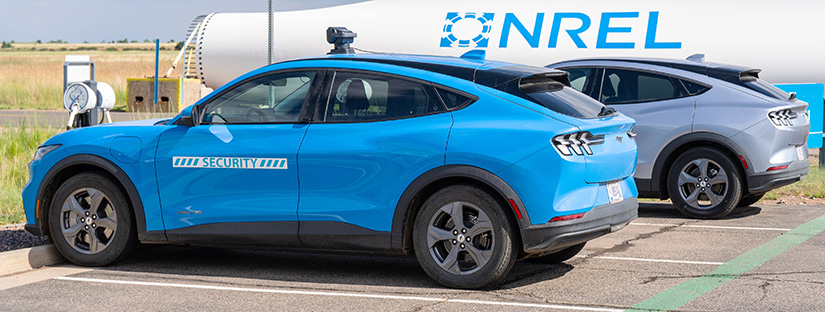Soft Cost Analysis of EV Charging Infrastructure Informs Transition to an Electric Fleet

Private and public electric vehicle supply equipment (EVSE)—the charging infrastructure necessary to support the rapid rise in electric vehicles (EVs)—are essential to the transformation of the transportation sector, yet associated expenses outside of the actual hardware, software, and construction called “soft costs” are not well understood.
A new multilaboratory initiative led by the U.S. Department of Energy’s (DOE’s) National Renewable Energy Laboratory (NREL) fills this gap.
Building on the novel NREL-led soft cost analysis project that began in 2010 and helped achieve cost reductions for solar technologies over the past decade, the laboratory is leveraging its learnings from the solar soft cost project’s success with Lawrence Berkeley National Laboratory and Idaho National Laboratory in an effort to achieve similar soft cost reductions for EVSE installations. Funded by the Joint Office of Energy and Transportation (Joint Office), the new project aims to find pathways to reduce soft costs for EVSE installation by identifying, benchmarking, and tracking relevant soft costs that will facilitate deployment of a nationwide network of chargers. The three national laboratories have been engaging different stakeholders, such as electrical utility organizations, federal agencies, and EVSE installation businesses, to understand their perspectives and collect data on various EVSEs, expenditures, and timelines for buildouts.
“Today’s electric vehicle charging infrastructure costs vary significantly—dependent on various factors such as the type of chargers and location—which can make current projects quite cumbersome to track and compare,” said NREL’s Ranjit Desai, the EVSE soft cost project principal investigator. “That’s why we’re taking a multipronged approach to solving this issue by obtaining invoices from state agencies, conducting stakeholder engagement to acquire critical data, and leveraging NREL’s extensive set of EV infrastructure tools that estimate the cost of charging station installation.”

Desai added that in the early stages of this effort, the project team has been focused on identifying the types of data needed to perform EVSE soft cost analyses, collecting the identified data and inputs from industry stakeholders, and tracking specific metrics and soft costs over time.
“One soft cost associated with EVSE charging installation is time. The longer the process takes, the more labor hours build within the soft costs of the project,” said NREL’s Erin Andrews-Sharer, a research project manager. “This project dives into the time associated with the permitting process for EV charging, which—according to many stakeholders and relevant literature—can be a variable and lengthy process but one that could be reduced with strategic efforts to streamline it.”
The EV charging industry, much like the solar industry a decade ago, has reached a point where it must streamline installation to reduce barriers to mass adoption. The direct costs of EVSE systems—software, hardware, physical enclosures, and plug connectors—have been widely studied. But much like solar soft costs, EVSE soft costs such as the capital associated with permitting, inspections, administration, customer acquisitions, and utility interconnections sometimes account for a larger portion of total installed system prices than direct costs in the United States.
To address this industry knowledge gap, the EVSE soft costs project team seeks to understand, document, and quantify the soft costs of EV charging infrastructure and identify specific mitigation strategies. The team’s technical achievements to date include conducting extensive literature reviews and both qualitative and quantitative analyses of permitting processes and analyzing more than 4,000 station buildout invoices across different states. EV service providers, state agencies, contractors, site hosts, and installers were among the primary stakeholders interviewed.
“We’re finding that land use and development codes, including zoning and permits, have the most variety across the nation,” Desai explained. “EV charging is not always explicitly outlined in codes, and even if they are, the lack of clarity within them and variance across the authorities that manage these processes leads to stakeholder uncertainty.”
Part of the research team’s quantitative analysis work involved NREL’s Electric Vehicle Infrastructure Locally Optimized Charging Assessment Tool and Estimator (EVI-LOCATE)—one of the newest additions to the laboratory’s flagship EVI-X Modeling Suite of Electric Vehicle Charging Infrastructure Analysis Tools—which is a site assessment tool that generates user-specific, site-specific, and location-specific EVSE site designs and cost estimates. Additionally, the research team developed a method to estimate the total costs for the station buildout invoices as well as compare the estimates with the invoices. The invoices that the research team obtained are from a large variety of station buildout projects, with detailed cost estimates for locations that have a single port to locations with more than 18 ports.
Partnership Opportunities for Data Collection
As the project moves forward, the research team continues to develop a visualization for an initial cost model that can incorporate various uncertainties of key inputs from stakeholder interviews. As more feedback is received, the model will continue to evolve and become even more refined, identifying opportunities and potential avenues to reduce EVSE soft costs. Additionally, the research team is developing a series of infographics based on the data collected for public use. The infographics will provide insight into variations and dependencies in project cost categories for use in benchmarking and identifying EVSE soft costs baselines.
“All cost data collected is anonymized and standardized to ensure organizational privacy,” Desai said. “We’re adhering to the engagement strategy that we’ve developed and continuously identifying new stakeholders to engage.”
A website to share engagement opportunities for identifying, tracking, and addressing soft costs is on track to be published later in 2024. The project’s findings will also be made publicly available later in the calendar year.
“With soft costs sometimes comprising more than half of the total cost of EVSE projects, it’s especially important to gain a sense of contributing factors and to have them well documented to help stakeholders mitigate soft costs, optimize, and increase the cost-effectiveness of their buildouts,” Desai emphasized. “Industry data will be essential to helping us build that knowledge base.”
Learn more about NREL's transportation and mobility research, including the laboratory's modeling suite of electric vehicle charging infrastructure analysis tools. And sign up for NREL's quarterly transportation and mobility research newsletter, Sustainable Mobility Matters, to stay current on the latest news.
Last Updated May 28, 2025
